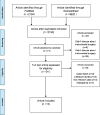Surgical Site Infection Management following Spinal Instrumentation Surgery: Implant Removal vs. Implant Retention: an Updated Systematical Review
- PMID: 35774842
- PMCID: PMC9233457
- DOI: 10.5455/aim.2022.30.115-120
Surgical Site Infection Management following Spinal Instrumentation Surgery: Implant Removal vs. Implant Retention: an Updated Systematical Review
Abstract
Background: The number of lumbar spine surgery increased in recent years. Spinal instrumentation surgery was an integral component in the treatment of spinal pathologies, which can cause surgical site infection (SSI). Surgical site infections (SSIs) are the leading cause of mortality and morbidity after spinal instrumentation surgery. The management of SSI was implant retention and removal is still unclear.
Objective: The objective of this literature is to systematically review the implant removal and retention method for SSI management after spinal instrumentation surgery.
Methods: We searched in PubMed and ScienceDirect for cohort and randomized control trial studies in English, published between 2002 and 2022, which had data on patients with spinal instrumentation surgery. The underlying disease, comorbidities, common bacteria, type of infection, the onset of infection, implant removal, and retention percentage and recommendation were analyzed. Bias analysis using Newcastle-Ottawa Quality Assessment.
Results: We included 15 studies with a total sample were 2.584 with an average of age 15 to 66 years old. The most common organism detected were S. Aureus, MRSA, and S. Epidermis. The most common surgical procedure indications were degenerative followed by scoliosis. Implant removal and retention rate were 0-100% and 0-90,32% respectively. Implant removal is more frequently used in patients after spinal instrumentation surgery than the implant retention method.
Conclusion: Implant retention can be performed in case of SSI is < 3 months after surgery. Implant removal is recommended if the incidence of SSI is > 3 months. Empirical antibiotics therapy is necessary to reduce the possibility of implant removal after debridement. Further studies on the effect of implant removal and retention in patients on infection recurrence, pain, and quality of life of patients are needed.
Keywords: SSI; implant; removal; retention; spinal instrumentation surgery..
© 2022 Andhika Yudistira, Syaifullah Asmiragani, Abdul Waris Imran, Muhammad Alwy Sugiarto.
Conflict of interest statement
There are no conflicts of interest.
Similar articles
-
Implant Retention or Removal for Management of Surgical Site Infection After Spinal Surgery.Global Spine J. 2020 Aug;10(5):640-646. doi: 10.1177/2192568219869330. Epub 2019 Aug 11. Global Spine J. 2020. PMID: 32677561 Free PMC article.
-
Risk factors for implant removal after spinal surgical site infection.Eur Spine J. 2018 Oct;27(10):2481-2490. doi: 10.1007/s00586-017-5294-1. Epub 2017 Sep 14. Eur Spine J. 2018. PMID: 28913559
-
Surgical debridement with retention of spinal instrumentation and long-term antimicrobial therapy for multidrug-resistant surgical site infections after spinal surgery: a case series.Int Orthop. 2016 Jun;40(6):1171-7. doi: 10.1007/s00264-015-3073-3. Epub 2015 Dec 21. Int Orthop. 2016. PMID: 26686674
-
Fate of Hardware in Spinal Infections.Surg Infect (Larchmt). 2020 Jun;21(5):404-410. doi: 10.1089/sur.2019.206. Epub 2019 Dec 18. Surg Infect (Larchmt). 2020. PMID: 31855116 Review.
-
Preoperative Versus Extended Postoperative Antimicrobial Prophylaxis of Surgical Site Infection During Spinal Surgery: A Comprehensive Systematic Review and Meta-Analysis.Adv Ther. 2020 Jun;37(6):2710-2733. doi: 10.1007/s12325-020-01371-5. Epub 2020 May 15. Adv Ther. 2020. PMID: 32415484 Free PMC article.
Cited by
-
Challenging the Dogma of Dead Space Obliteration With Muscle Flaps in Deep Spinal Surgical Site Infections.Plast Reconstr Surg Glob Open. 2025 May 1;13(5):e6732. doi: 10.1097/GOX.0000000000006732. eCollection 2025 May. Plast Reconstr Surg Glob Open. 2025. PMID: 40321322 Free PMC article.
-
The efficacy of wound edge protectors in reducing the post-operative surgical site infections after abdominal surgery: a meta-analysis of randomized clinical studies.Wideochir Inne Tech Maloinwazyjne. 2023 Dec;18(4):541-550. doi: 10.5114/wiitm.2023.132070. Epub 2023 Oct 12. Wideochir Inne Tech Maloinwazyjne. 2023. PMID: 38239586 Free PMC article.
-
Removal of Spinal Instrumentation Is Not Required to Successfully Treat Postoperative Wound Infections in Most Cases.Cureus. 2024 Mar 18;16(3):e56380. doi: 10.7759/cureus.56380. eCollection 2024 Mar. Cureus. 2024. PMID: 38633938 Free PMC article.
References
-
- Rathjen K, Wood M, McClung A, Vest Z. Clinical and radiographic results after implant removal in idiopathic scoliosis. Spine (Phila Pa 1976) 2007 Sep;32(20):2184–8. - PubMed
-
- Ntilikina Y, Bahlau D, Garnon J, Schuller S, Walter A, Schaeffer M, et al. Open versus percutaneous instrumentation in thoracolumbar fractures: magnetic resonance imaging comparison of paravertebral muscles after implant removal. J Neurosurg Spine. 2017 Aug;27(2):235–41. - PubMed
Publication types
LinkOut - more resources
Full Text Sources

